孟加拉邦戈都国际会议中心,达卡,孟加拉
建筑设计:柴裴义/北京市建筑设计研究院
建筑设计:张永和/非常建筑
孟加拉邦戈都国际会议中心,达卡,孟加拉
建筑设计:柴裴义/北京市建筑设计研究院
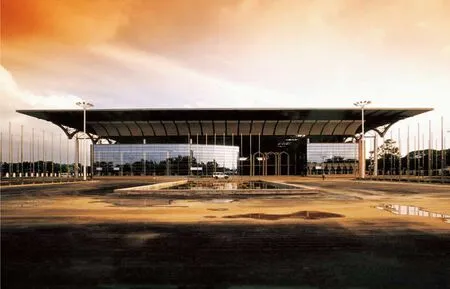
1 外景/Exterior view
孟加拉邦戈都国际会议中心(孟中友好会议中心)位于孟加拉国达卡市,是中国政府援建项目。该项目包括:1670人国际会议大厅,两个400人国际会议厅, 均带4国语言同声传译系统; 700人宴会厅、贵宾厅及谈判间、新闻发布中心、电视转播室、自由工作间、商务中心、大会秘书处、祈祷室、咖啡厅,以及相关的文件中心、工作间、翻译室、医疗中心、咖啡兼快餐厅等辅助功能用房。
当地的亚热带气候条件和伊斯兰建筑文化传统是方案创意的着眼点。
由于采取了遮阳、防辐射、自然通风等生态节能措施,孟加拉邦戈都国际会议中心在使用中大约可节省20%的能耗;同时,因为在中庭部分采取了自然通风、绿化、水池等方法,从而省去了集中空调,又能节省10%左右的能耗。所以,在采取了多种生态节能措施之后,孟加拉邦戈都国际会议中心在使用中,大约可节省25%~30%的总能耗,并能给使用者提供一个舒适、宜人的场所环境。
对于当地建筑文化传统的呼应,设计中采用的是以现代主义的设计手法为基础,在具体形式、材料上适当借鉴伊斯兰建筑风格为烘托的思路。钢结构连续拱券造型的屋顶、大会议厅的穹顶、拱券门、花格装饰等突出了伊斯兰建筑的地方特色。
采用当地常用的劈离砖、花格砖做内外饰面及楼地面材料,手法新颖,处理细致,成本低廉。
项目信息/Credits and Data
主持建筑师/Principal Architect: 柴裴义/CHAI Peiyi建筑设计团队/Project Team: 叶依谦/YE Yiqian
Bangabandhu International Conference Center (BICC or Bangladesh Friendship Conference Center) is located in Dhaka, Bangladesh. It is a construction project aided by the Chinese government. BICC has a 1670-seat international conference hall, two 400-seat international conference halls, all of which are equipped with simultaneous interpretation system for up to four languages, and a banquet hall that accommodates 700 people. It also includes VIP lounge, negotiation room, news center, television broadcasting studio, free workroom, business center, secretariat of the conference, prayer room, coffee room, and related auxiliary functional rooms like document center, work studio, translation center, clinical center, café and snack bar etc.
Subtropical climate and Islamic architectural culture and traditions are the focus of the proposal.
By adopting ecological energy-saving measures like shading, anti-radiation and natural ventilation etc., about 20% of the energy consumption of BICC is saved. At the same time, instead of central air conditioner, vegetation and pools are applied to achieve natural ventilation in the atrium so that another 10% of energy consumption is saved. Therefore, after the adoption of various ecological energy-saving measures, about 25% to 30% of the total energy consumption can be saved in BICC, which provides its users with a comfortable and pleasant environment.
In order to echo the local traditional architectural culture, while modernism is adopted as the design basis, Islamic architectural styles are much considered in the image design and material selection. The roof of continuous steel-structured arches, the dome, the arch door and tracery decoration of the grand conference hall highlight the local characteristics of Islamic architecture.
The adoption of the common local split bricks and lattice bricks as flooring materials and internal and external finish displays a novel style in design at low cost.

2 外景/Exterior view

3 二层平面/Floor 1 plan

4 内景/Interior view
评论
柳亦春:一个巨型的覆盖既应对了当地的亚热带气候,又是决定建筑形式的最主要元素。形式既来自于网架覆盖的结构合理性,也来自于建筑师对当地建筑传统符号的提炼与演绎。这个建筑对气候的考虑通过空间思考来完成,既是为了节约能耗,也塑造了舒适宜人的场所与环境。这是一种建筑学的方法,而不是技术的方法,它是包含着文化内涵的。圆形穹顶的大会议厅进一步强化了建筑的地方性传统空间氛围,并成为整个建筑空间的高潮,它和巨大的网架覆盖有一定的语言的差异,但由于它的内向性特点,以及网架结构在一个方向上的拱形提示,使它们仍能作为一个整体而存在。张悦:在喜马拉雅南麓的阳光和雨水中,建筑巨大屋盖所形成的灰空间无疑是一种理性的选择,为巨大使用人群提供了集散休憩的空间,同时很好地满足了遮蔽与通风的功能。项目通过室内空间塑造、空间网架选型、入口符号性提示等应答了文化诉求,并使之融合到整体性之中。
Comments
LIU Yichun: A huge cover responds to the local subtropical climate, which is also the main factor in determining the architectural form. The form is based on the rationality of the grid structure as well as the architects' personal interpretation of the local traditional architectural symbols. In this case, the climate factors are incorporated through contemplation on the space, so as to save energy and create a comfortable and pleasant environment. With cultural connotations, it is a method in architecture rather than in technique. The grand conference hall, with a round dome, further strengthens the local traditional spatial ambiance of the architecture, turning into the climax of the whole architectural space. Despite the language difference from the grid cover, the dome forms an inward arch on the grid structure, making the architecture an integral whole.
ZHANG Yue: The grey space under the huge roof is undoubtedly a rational choice in consideration of the sun and the rain at the southern foot of Himalayas. It provides an open public space for gathering and at the same time fulfils the functional requirements for shelter and ventilation. Through the interior space, grid structure and the symbolic details at the entrance, the building made its connection to Islamic culture.
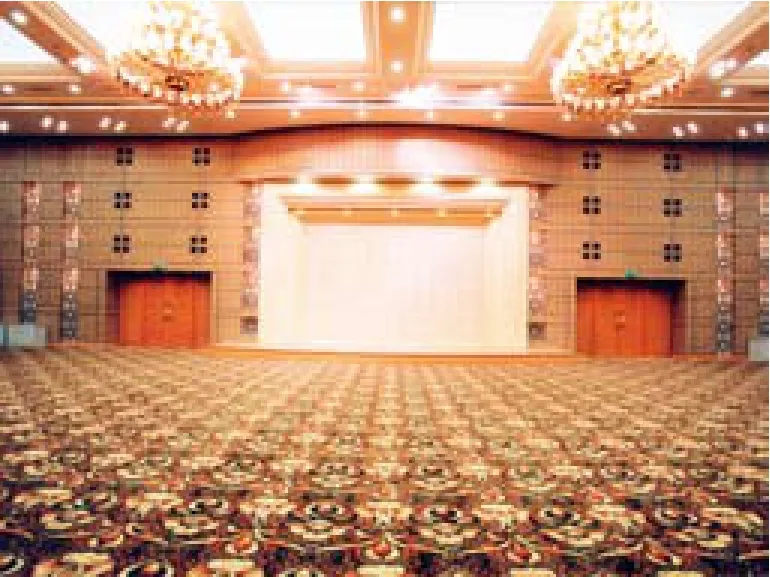

5.6 内景/Interior view

7 东立面/East elevation

8 剖面/Section
三湖出版社,坡州,韩国
建筑设计:张永和/非常建筑

1 东立面外景/Exterior view, east elevation
坡州是汉城附近的一个出版业新城。三湖出版社的基地是城中一个街区,四边条件各不相同:北面是公共绿地,东面是一条交通干道,南面是一条人车分享的街道,西面则是一条步行商业街。三湖出版社所要建的这栋建筑中有4个功能:办公室,书店,画廊,业主公寓,以及其他一些公司成员的潜在住所。对这两组条件的分析启发了一个由4个相对独立的盒子组合构成的设计概念:在底层,书店或“商业建筑”与西侧步行商业街平行;位于东侧的音乐厅/画廊或“文化建筑”以较封闭的立面面对交通干道的车流。叠摞在这两个盒子上、同时在平面上与之构成90°交角的是临街的“办公盒子”和北侧相对私密又向绿地开敞的“住宅盒子”。上层建筑与下层建筑的直角关系使办公与住宅获得日照,同时也形成一个中心院落,将城市空间延续到建筑中来。4个盒子在立面材料上的处理是不同的。文化、商业、办公、住宅盒子的立面材料分别是水泥板、铝板、木板和绿化。
建造过程中,因业主要求,取消了住宅功能,代替的是一盒花园,其外表面会被绿色攀缘植物所覆盖。
A block of the Paju Book City, the site is defined by four different edges: public green space on the north, major thoroughfare on the east, pedestrian and vehicle shared street on the south, pedestrian oriented shopping mall on the west. Housing the publisher Samho, the building has a four-fold program: offices, bookstore, concert hall plus gallery, and apartments for the owner and possibly a few others in the company. The analysis of these two sets of given conditions generates an architecture design of four components or four relatively independent two-story micro-structures: On the ground level, bookstore/Commercial Building on the west aligned with other retails, concert hall-gallery/Cultural Building on the east with an enclosed elevation toward the traffic lanes; stacked on the upper level and turned 90 degrees, Office Building on the street front south while Residential Building on the more private north side facing the landscape. The rotation of the upper buildings offers southern exposure to the offices and apartments and, together with two buildings bellow, forms an open center space, which brings urbanity inside the complex. Each micro-building is further distinguished by a distinct sectional organization and with the natural material that makes up the inner content of the "sandwich" glass curtain wall: earth, reed, cotton, and wood shavings for Cultural, Commercial, Residential and Office respectively.

2 概念图示/Concept diagram

3 北立面外景/Exterior view, north elevation
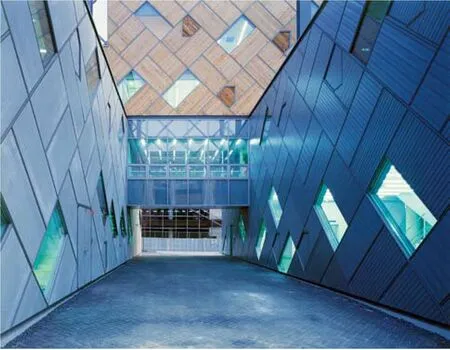
4 内街/Internal street
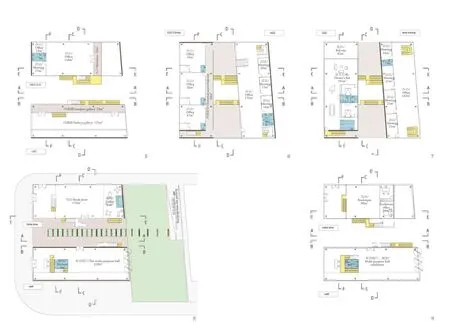
5 三层平面/Floor 2 plan6 四层平面/Floor 3 plan7 五层平面/Floor 4 plan8 首层平面/Floor 0 plan9 二层平面/Floor 1 plan
评论
龙灏:当围合从二维跃升至三维,“空”和“间”不期而至。坡州三湖出版社的设计由4个相对独立的盒子构成,通常存在于平面的由“空”产生的相互联系向竖向巧妙延伸,围合在竖向出现了间隙,使内外得以延续,4个盒子的组合体提供了一条立体的空气的通道。然而,姿态过于突出的外墙与三维的“空”与“间”平分秋色,可能会分散人们对此巧妙围合的体会。
青锋:这是非常建筑又一个具有城市特点的建筑项目。办公、住宅以及书店与商业建筑,对应于《雅典宪章》所定义的工作、居住与休憩这三大城市功能,而建筑师采用的策略也类似于《雅典宪章》,将不同的功能单元放在相对独立的盒子里,再通过多重交通体系相互连接。不过,在一个中型建筑中,并不存在城市割裂与活力丧失的问题,为建筑带来清晰的多样性与逻辑性是这一“城市”策略最重要的价值。
项目信息/Credits and Data
客户/Client: 三湖出版社/Samho
主持建筑师/Principal Architect: 张永和/Yung Ho Chang
建筑设计团队/Project Team: 刘向晖,杜鹃,张辉扬,Lucas Gallardo,尚荔/LIU Xianghui, DU Juan, ZHANG Huiyang, Lucas Gallardo, SHANG Li
结构咨询/Structural Consultant: 徐民生/XU Minsheng
合作建筑师/Associate Architect: 韩国履露斋建筑事务所/ Iroje Architects & Planners, Seoul, Korea
建筑面积/Floor Area: 2895m2
摄影/Photos: Jong Oh Kim
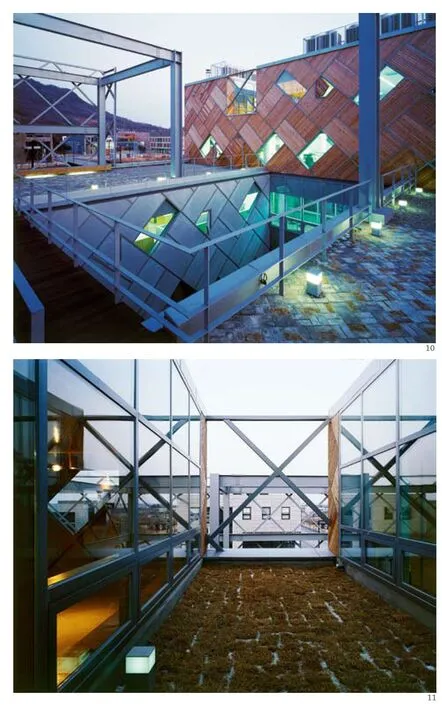
10.11 屋顶平台/Roof terrace

12 B-B剖面/B-B section
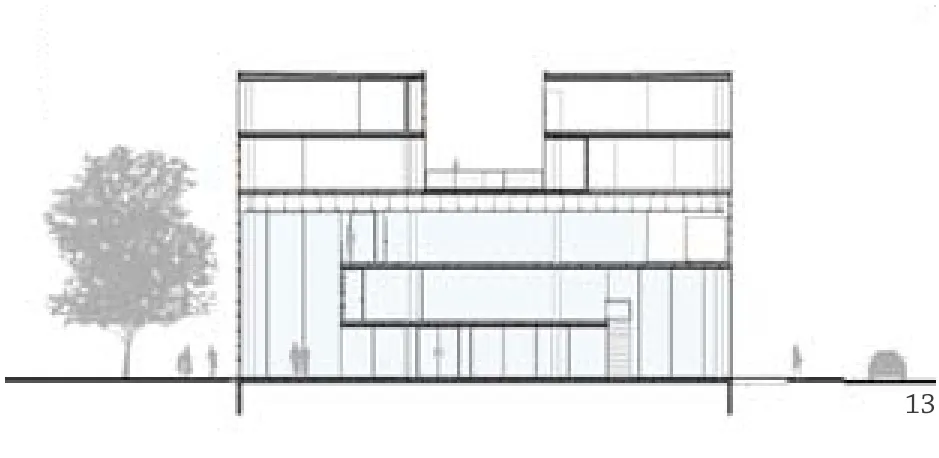
13 E-E剖面/E-E section

14 C-C剖面/C-C section

15 F-F剖面/F-F section
Comments
LONG Hao: By lifting the enclosing from 2D to 3D, the unexpected space is obtained. The design of the Samho Building, Paju, Korea, composes of four relatively independent boxes. The horizontal relevance produced by the space in the plane ingeniously extends vertically. The vertical gaps in the enclosing also connect the inner and the outer space. The four-box block forms a 3D channel for the air. However, the prominent outer walls of the boxes share the ingenuity equally with the amazing 3D space, which may distract the viewers' attention from this subtle enclosing.
QING Feng: It is another architectural project with urban characteristics coming out of the Atelier Feichang Jianzhu. Office, residence and commercial spaces correspond to the three main functions defined by the Athens Charter-work, habitation and leisure. The architect used the same strategy proposed by the Athens Charter: separate different functions into rather independent boxes, and connect them with multiple "traffic" routes. In a middle-size project like this, there is no need to worry about the segregation and degeneration of urban life. To give the architecture a manifest diversity and logic is the key value of its "urban" strategy.
BangGe BangDu International Conference Center, Dhaka, Bangladesh, 2001
Architects: CHAI Peiyi/Beijing Institute of Architectural Design
Samho Building, Paju, R.O.Korea, 2006
Architects: Yung Ho Chang/Atelier Feichang Jianzhu

16 内景/Interior view

